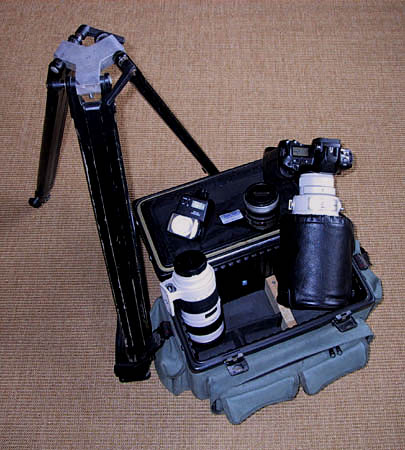Home Biography Image of the Month Reports Photo Gallery e-mail
It took several years of experience, until I found the photographic equipment that meets all
my needs. The picture on the right hand site gives you an idea about my decision.
1. Camera CANON EOS 7D MKII
In the next chapters, I would like to give you the information, that has lead me to this decision.
Years ago, I read a book about nature photography which stated that a successful
nature photographer needs only a 35mm lens, a 80-200mm zoom, and a 400mm telephoto.
For the most part, I agreed with that statement, and for several years photographed
with a 35-70mm zoom, a 70-200mm zoom and a 400mm telephoto. This equipment allowed
me to photograph nearly everything I wanted, and very seldom did I miss a picture
due to focal length. Today, however, I would also suggest having the capabilities
of 600mm, to more easily photograph the very shy European animals. Because of this,
I selected the f2.8/300mm telephoto with the 1.4x and 2x extenders. This gives me
the capability to use the lens as a f4/420mm or f5.6/600mm. Even though I consider
an aperture of f4 as ideal, f5.6 is a good compromise for the increased focal
length. Professional photographers will probably want to choose a f4/500mm or
f4/600mm with the converters to achieve even greater focal lengths. On the other
hand, these lenses are bigger and heavier, and I prefer that all of my equipment fit
into a hand-size luggage bag, so I can carry it with me on a plane.
The f2.8/70-200mm also works very well with the 1.4x tele-extender, giving me the
capability of a f4/98-280mm zoom, and with the 2x tele-extender giving me a focal
length of f5.6/140-400mm. Combining it with the 3.5-4.5/24-85, I can cover a focal length
from 24 - 280mm with an ideal aperture of f4, and up to 400mm at f5.6. With these
two lenses, you will be able to photograph much of what you see in nature, especially
if you work in USA, Africa and Australia. As a plus, they are also light, so you can
take them on extended hikes.
You should also select lenses with a fixed front lens, so that they do not turn
while focusing. This will simplify the use of polarizing filters. This is the case
with my 24-85mm and the 70-200mm zooms.
For macro photography I use a 25mm extension tube with the f2.8/70-200mm zoom.
This enables me to get a macro ratio of about 1:3, which is enough to photograph
most butterflies, dragonflies, flowers, lizards and other types of smaller wildlife.
|
